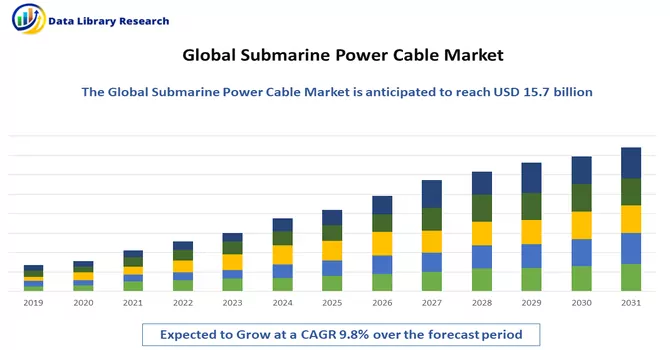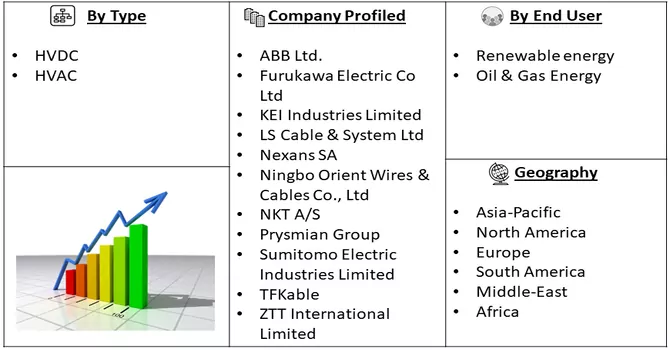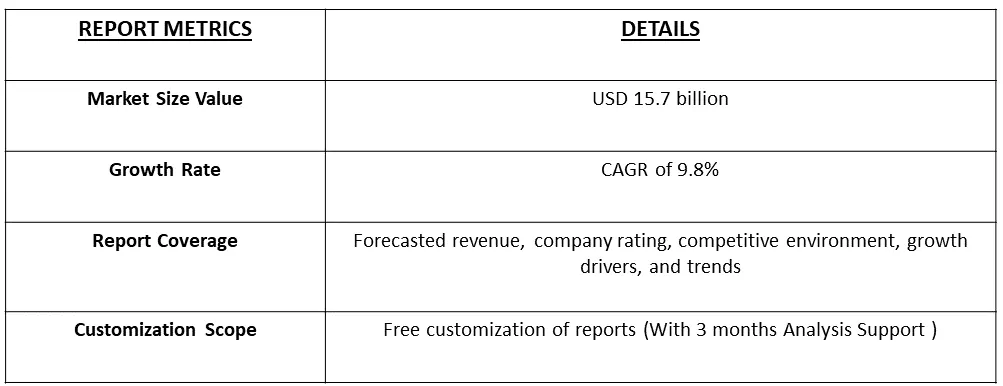Submarine Power Cable Market Size was valued at USD 15.7 billion in 2023. The submarine power cable market industry is projected to grow at a CAGR of 9.8% over the forecast period, 2024-2031.

Get Complete Analysis Of The Report - Download Free Sample PDF
Submarine power cables are specialized electrical cables meticulously designed for the transmission of electrical power beneath water surfaces. These cables are engineered to address the unique challenges presented by submersion in diverse bodies of water, spanning seas, oceans, lakes, and rivers. The significance of submarine power cables lies in their pivotal role in connecting offshore energy sources, such as offshore wind farms and oil and gas platforms, to onshore power grids. The engineering of submarine power cables involves several critical considerations to ensure their effectiveness in underwater environments. One of the primary challenges is water resistance, as these cables must endure prolonged submersion without compromising their electrical transmission capabilities. To achieve this, multiple layers of insulation and protective materials are incorporated to prevent water ingress and maintain the integrity of the cable.
The escalating demand for enhanced global connectivity, driven by the surge in digitalization, widespread adoption of cloud computing, and the proliferation of data centers, is fueling a heightened need for high-capacity submarine cables. These cables play a pivotal role in facilitating secure and swift data transmission across continents, contributing significantly to the flourishing global digital economy. As businesses and individuals increasingly depend on seamless and rapid data exchange, the importance of robust submarine cable infrastructure becomes paramount. These cables serve as critical conduits for international data transfer and act as foundational elements supporting the interconnected nature of modern digital services, ensuring the efficiency and reliability of global communication networks. The necessity for regular maintenance, repair, and upgrades of existing submarine cable systems creates a sustained market opportunity for service providers, with proactive maintenance ensuring the longevity and reliability of the installed infrastructure.
There is a discernible trend in the development of multi-functional submarine cables, which are designed to serve the dual purposes of power transmission and data communication. These versatile cables represent a strategic response to the evolving demands of integrated communication and energy initiatives. By combining the capabilities of transmitting both power and data within a single cable, these adaptable solutions contribute significantly to cost-effectiveness in the implementation of projects that require diverse functionalities.The integration of power and communication functionalities into a unified cable has several advantages. Firstly, it streamlines infrastructure by eliminating the need for separate systems for power and data transmission, leading to a more efficient use of resources. This integrated approach not only simplifies the installation process but also reduces the overall complexity of the project.
Market Segmentation: The report covers the Global Submarine Power Cable Market Share & Manufacturers. The market is segmented by Type of Current (HVDC and HVAC), End User (Renewable energy and Oil & Gas Energy) and Geography (North America, Europe, Asia-Pacific, South America and Middle-East and Africa).

For Detailed Market Segmentation - Download Free Sample PDF
Market Drivers:
Growing Consumption of Global Data Consumption
The global surge in data consumption, driven by the widespread adoption of online content, streaming services, and data-intensive applications, emphasizes the critical need for high-capacity submarine cables. These cables are indispensable in addressing the growing demand for fast and reliable data transmission between continents. In an evolving digital landscape where seamless connectivity is paramount for individuals and businesses, high-capacity submarine cables play a central role in facilitating swift global data exchange. Whether supporting high-definition content streaming, enabling real-time communication, or powering data-intensive applications, these cables serve as the backbone of a resilient and efficient international data infrastructure. Their presence ensures a responsive and interconnected digital experience for users worldwide.
Growing Emphasis on Energy Resources
The growing emphasis on renewable energy, particularly through offshore wind farms, is elevating the necessity for submarine cables to establish connectivity between these energy installations and onshore grids. Submarine cables play a crucial role in guaranteeing the efficient transmission of power generated offshore, serving as indispensable components in the energy infrastructure. These cables facilitate the smooth and effective transfer of electricity from offshore renewable sources to onshore locations. With the increasing global momentum towards sustainable energy, the demand for submarine cables as vital conduits for offshore power transmission is consistently on the rise.
Market Restrains:
High Initial Investment Costs
The deployment of submarine cable systems necessitates a substantial initial investment that encompasses manufacturing, laying, and continuous maintenance. The considerable upfront costs associated with these activities can serve as a deterrent, particularly for projects or regions grappling with budgetary constraints. The substantial financial commitment involved in both the establishment and ongoing maintenance of these cable systems can pose challenges, especially in areas where financial resources are limited. This financial barrier may impede the adoption of submarine cable systems, highlighting the need for innovative financing solutions and strategic planning to overcome budgetary constraints and promote the development of robust undersea communication and energy infrastructure.
The COVID-19 pandemic has significantly impacted the submarine power cable market, introducing challenges and disruptions to the industry. The global supply chain for submarine cable components faced disruptions due to lockdowns, travel restrictions, and manufacturing shutdowns, leading to delays in project timelines and increased costs. The uncertainty surrounding the pandemic also affected investment decisions and financing for new projects, causing a slowdown in the development of offshore renewable energy installations that heavily rely on submarine power cables for connectivity. Despite these challenges, the pandemic highlighted the importance of resilient and reliable energy infrastructure, potentially driving increased focus and investments in the submarine power cable market as economies strive to recover and transition towards sustainable energy solutions in a post-pandemic world.
Segmental Analysis:
HDVC Segment is Expected to Witness Significant Growth Over the Forecast Period
The convergence of High-Voltage Direct Current (HVDC) technology and the Submarine Power Cable Market forms a critical nexus in the dynamic energy sector. Recognized for its efficient long-distance power transmission capabilities, HVDC technology plays a pivotal role in the submarine power cable domain. As the demand for renewable energy, particularly from offshore wind farms, continues to rise, the establishment of resilient power transmission infrastructure becomes imperative. This strategic partnership not only addresses the challenges associated with long-distance power transmission but also facilitates the smooth integration of renewable energy into existing grids. Ongoing advancements in both HVDC systems and submarine power cables further elevate system performance, reliability, and overall efficiency, solidifying this collaboration as a cornerstone in the evolution of a contemporary, sustainable energy infrastructure.
Renewable Energy Segment is Expected to Witness Significant Growth Over the Forecast Period
Renewable energy and submarine power cables are integral components of the transition to sustainable power sources. Submarine power cables play a key role in connecting offshore renewable energy installations, such as wind farms and hydroelectric plants, to onshore grids. They facilitate the efficient transmission of electricity over long distances, enabling the integration of clean energy into the broader electrical infrastructure. Whether linking offshore wind farms to onshore grids or interconnecting various renewable energy sources, these cables contribute to a more sustainable and interconnected global energy landscape, addressing the environmental challenges posed by traditional fossil fuel-based power generation.
Asia Pacific Region is Expected to Witness Significant Growth Over the Forecast Period
In the Asia Pacific region, the deployment of submarine power cables plays a pivotal role in fostering regional energy connectivity and sustainability. As the demand for electricity continues to soar in this dynamic and rapidly growing part of the world, submarine power cables are instrumental in linking diverse energy sources, including offshore wind farms and hydropower installations, to onshore grids. These cables not only facilitate the efficient transmission of power across vast distances but also contribute to the integration of renewable energy into the overall energy mix. The Asia Pacific's strategic focus on enhancing energy infrastructure, coupled with advancements in submarine cable technology, positions this region as a key player in fostering a resilient, interconnected, and environmentally conscious energy network that addresses the evolving energy needs of its diverse nations.

Get Complete Analysis Of The Report - Download Free Sample PDF
The analyzed market exhibits a high degree of fragmentation, primarily attributable to the presence of numerous players operating on both a global and regional scale. The competitive landscape is characterized by a diverse array of companies, each contributing to the overall market dynamics. This fragmentation arises from the existence of specialized solution providers, established industry players, and emerging entrants, all vying for market share. The diversity in market participants is underscored by the adoption of various strategies aimed at expanding company presence. On a global scale, companies within the studied market are strategically positioning themselves through aggressive expansion initiatives. This often involves entering new geographical regions, targeting untapped markets, and establishing a robust global footprint. The pursuit of global expansion is driven by the recognition of diverse market opportunities and the desire to capitalize on emerging trends and demands across different regions. Simultaneously, at the regional level, companies are tailoring their approaches to align with local market dynamics. Regional players are leveraging their understanding of specific market nuances, regulatory environments, and consumer preferences to gain a competitive edge. This regional focus allows companies to cater to the unique needs of local clientele, fostering stronger market penetration. To navigate the complexities of the fragmented market, companies are implementing a range of strategies. These strategies include investments in research and development to stay at the forefront of technological advancements, mergers and acquisitions to consolidate market share, strategic partnerships for synergies, and innovation to differentiate products and services. The adoption of such multifaceted strategies reflects the competitive nature of the market, with participants continually seeking avenues for growth and sustainability. In essence, the high fragmentation in the studied market not only signifies the diversity of players but also underscores the dynamism and competitiveness that drive ongoing strategic maneuvers. As companies explore various avenues for expansion, the market continues to evolve, presenting both challenges and opportunities for industry stakeholders. Some of the major players working in this market segment are:
Recent Development:
1) In January 2024, NEC Corporation India (NEC India) has successfully finalized a flagship optical submarine cable system in Southern India, establishing a vital link between Kochi and the Lakshadweep Islands. This significant achievement, known as the Kochi-Lakshadweep Islands Submarine Cable (KLI), aligns with the objectives of the Government of India's 'Digital India' Mission. The completion of the KLI submarine cable system is poised to have a positive impact on the broader submarine cable market, showcasing the demand and commitment to bolstering digital infrastructure for regional development and connectivity initiatives.
2) In June 2023: Japan, the United States, and Australia unveiled plans for a collaborative effort to construct an undersea cable aimed at enhancing internet connectivity in Pacific Island nations. This joint initiative, backed by a combined investment of approximately USD 95 million (¥13 billion yen), is designed to counter the expanding influence of China in the region. Leading the project is Japan's NEC Corp., with an anticipated completion date around 2025. The 2,250-kilometer subsea fibre-optic cable will link Micronesia, Nauru, and Kiribati. In addition to funding, Tokyo, Washington, and Canberra will contribute to the development of associated ground-based facilities and provide technical assistance to ensure the success of this strategic connectivity endeavor.
Q1. What was the Submarine Power Cable Market size in 2023?
As per Data Library Research Submarine Power Cable Market Size was valued at USD 15.7 billion in 2023.
Q2. At what CAGR is the Submarine Power Cable market projected to grow within the forecast period?
Submarine Power Cable market is projected to grow at a CAGR of 9.8% over the forecast period.
Q3. What are the factors driving the Submarine Power Cable market?
Key factors that are driving the growth include the Growing Consumption of Global Data Consumption and Growing Emphasis on Energy Resources.
Q4. What Impact did COVID-19 have on the Submarine Power Cable market?
The COVID-19 pandemic has significantly impacted the submarine power cable market, introducing challenges and disruptions to the industry. For detailed insight request a sample here.
Data Library Research are conducted by industry experts who offer insight on industry structure, market segmentations technology assessment and competitive landscape (CL), and penetration, as well as on emerging trends. Their analysis is based on primary interviews (~ 80%) and secondary research (~ 20%) as well as years of professional expertise in their respective industries. Adding to this, by analysing historical trends and current market positions, our analysts predict where the market will be headed for the next five years. Furthermore, the varying trends of segment & categories geographically presented are also studied and the estimated based on the primary & secondary research.
In this particular report from the supply side Data Library Research has conducted primary surveys (interviews) with the key level executives (VP, CEO’s, Marketing Director, Business Development Manager and SOFT) of the companies that active & prominent as well as the midsized organization
FIGURE 1: DLR RESEARH PROCESS

Extensive primary research was conducted to gain a deeper insight of the market and industry performance. The analysis is based on both primary and secondary research as well as years of professional expertise in the respective industries.
In addition to analysing current and historical trends, our analysts predict where the market is headed over the next five years.
It varies by segment for these categories geographically presented in the list of market tables. Speaking about this particular report we have conducted primary surveys (interviews) with the key level executives (VP, CEO’s, Marketing Director, Business Development Manager and many more) of the major players active in the market.
Secondary ResearchSecondary research was mainly used to collect and identify information useful for the extensive, technical, market-oriented, and Friend’s study of the Global Extra Neutral Alcohol. It was also used to obtain key information about major players, market classification and segmentation according to the industry trends, geographical markets, and developments related to the market and technology perspectives. For this study, analysts have gathered information from various credible sources, such as annual reports, sec filings, journals, white papers, SOFT presentations, and company web sites.
Market Size EstimationBoth, top-down and bottom-up approaches were used to estimate and validate the size of the Global market and to estimate the size of various other dependent submarkets in the overall Extra Neutral Alcohol. The key players in the market were identified through secondary research and their market contributions in the respective geographies were determined through primary and secondary research.
Forecast Model
